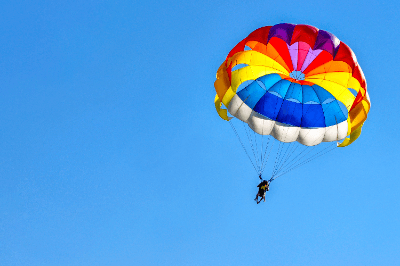What Is a Parachute?

A parachute is a device with an umbrella-like shape designed to control the descent speed by harnessing the force of air resistance.
Commonly used to drop people or supplies from aircraft during flight, it ensures a safe landing by utilizing air resistance. The term “parachute” is a coined word, combining the Italian “parare” meaning to protect, and the French “chute” meaning to fall. It is also referred to as a “falling umbrella.”
Initially made of silk, early parachutes faced accidents due to increased weight in humid conditions or failure to deploy. With the shift to materials like nylon, a synthetic fiber, such accidents have significantly reduced.
Uses of Parachute
Parachutes find applications in various areas:
1. Skydiving
Skydiving is a sport involving jumping out of airplanes and deploying a parachute in mid-air. Without a parachute, rapid descent poses a danger, but the parachute allows a gradual descent to the ground.
2. Emergency Ejection
Parachutes are integral components of emergency ejection systems used in aircraft. When deployed, the parachute ensures a safe descent for the crew.
3. Military Operations
In military operations, parachutes are employed for rapid descent to the designated destination.
4. Airdropping Cargo
For military and emergency supply transport, parachutes are used to deliver cargo to the ground. The parachute slows down the descent, facilitating safe retrieval on the ground.
5. Spacecraft Reentry
Parachutes are utilized during the return of spacecraft to Earth.
Principle of Parachute
A parachute functions by utilizing air resistance to slow down the descent speed of an object. As the parachute opens up, air resistance is generated. The greater this resistance, the slower the descent speed becomes. The size and shape of the parachute influence the magnitude of resistance and stability, requiring careful consideration.
Fundamentally, parachutes can be maneuvered left or right based on wind direction. With proper control, ascents and descents are also possible. However, parachute control demands significant expertise and specialized knowledge. Adequate training is crucial to ensure safety during parachute use.
Types of Parachutes
Several types of parachutes are tailored for specific uses and characteristics:
1. Round Parachute
Round parachutes have a circular shape with fabric radiating from the center. Due to their simple structure and high stability, they are used for emergency ejections and cargo airdrops. However, they lack maneuverability.
2. Square Parachute
Square parachutes are square-shaped and inflate as air enters, providing high glide performance and excellent maneuverability. They are commonly used in skydiving and paragliding.
Other Information on Parachute
History of Parachute
The history of parachutes dates back to medieval times, with an early record from 852 AD when Andalusian man Armen Firman jumped off a tower in Cordoba, Spain, using a reinforced cloak and landed safely with minor injuries.
The invention of the parachute is often attributed to Leonardo da Vinci’s sketches around 1485, though similar designs appear in Italian literature before this. In 1783, Frenchman Louis-Sébastien Lenormand reinvented the parachute, coining the term. Jean-Pierre Blanchard achieved the first successful parachute jump from a hot air balloon in 1793.
Modern parachutes made of silk were developed in the late 18th to early 19th centuries. The first airplane parachute jump occurred in 1912, followed by the first patent for a modern parachute in 1913. Mandatory parachute use for military pilots began after a 1922 survival incident from a plane crash in the United States.